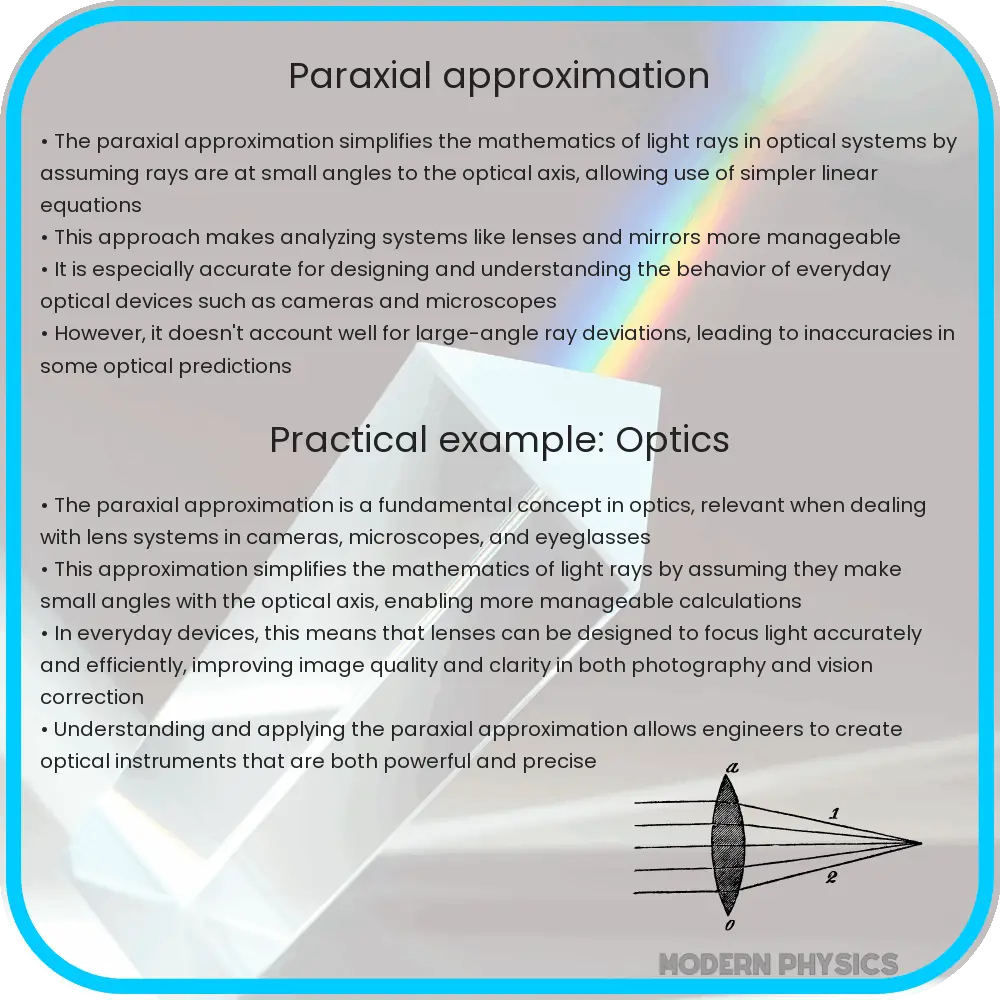Explore the basics and applications of paraxial approximation in geometrical optics, its precision, limitations, and advanced computational solutions.

Understanding the Paraxial Approximation in Geometrical Optics
The realm of geometrical optics, a branch of physics, is enriched by the concept of paraxial approximation. This simplification plays a crucial role in analyzing and designing optical systems such as lenses, mirrors, and telescopes. The paraxial approximation, also known as the Gaussian approximation, assumes that light rays are incident at small angles to the optical axis, allowing for simpler mathematical treatments.
Basics of Paraxial Approximation
At the heart of the paraxial approximation lies the small angle approximation. In this regime, the sine and tangent of an angle are approximated to the angle itself, measured in radians. This assumption significantly simplifies the complex trigonometric calculations in ray tracing. As a result, the behavior of light rays in optical systems can be accurately predicted without resorting to intensive computational methods.
Mathematically, if θ is the angle of incidence or refraction, the paraxial approximation assumes sin(θ) ≈ tan(θ) ≈ θ. This approximation is valid only when θ is considerably small, typically less than about 10 degrees. The accuracy of this approximation diminishes as the angle increases, making it unsuitable for wide-angle optical systems.
Applications in Optical Design
Paraxial approximation finds extensive use in the design and analysis of optical instruments. By applying this approximation, optical designers simplify the equations governing lens systems. This simplification is especially beneficial in the initial stages of optical design, where it helps in establishing the fundamental layout of the optical system. For instance, in lens design, the paraxial approximation aids in calculating focal lengths, image and object distances, and magnification factors with relative ease.
Moreover, this approximation is instrumental in the derivation of lens maker’s formula and the mirror equation, fundamental tools in the design of optical components. These formulas, under the paraxial approximation, provide a first-order approximation of the behavior of light in optical systems, laying the groundwork for more detailed design and analysis.
Precision and Limitations
While the paraxial approximation is a powerful tool in geometrical optics, its precision is inherently limited. The approximation holds well for small angles but fails to accurately describe optical phenomena involving larger angles of incidence. This limitation is particularly evident in wide-angle lenses and off-axis optical elements, where the paraxial approximation can lead to significant errors in predicting optical performance.
To address these limitations, advanced optical design often requires the use of more complex mathematical models that go beyond the paraxial approximation. These models take into account higher-order terms in the angle, providing a more accurate representation of the optical behavior in systems where large angles are involved.
Enhancing Optical Precision Beyond Paraxial Approximation
For applications demanding high precision, particularly in wide-angle and high-resolution optics, the limitations of paraxial approximation necessitate more refined methods. Techniques like ray tracing, which do not rely on small angle approximations, are employed to model the behavior of light with greater accuracy. Ray tracing algorithms calculate the path of light rays through an optical system without the simplifying assumptions of the paraxial approximation, capturing the nuances of wide-angle and aberrated systems.
Aberration theory also plays a significant role in this context. It involves the study of deviations from ideal optical performance, known as aberrations, which are not accounted for in the paraxial approximation. By understanding various aberrations such as spherical, chromatic, and astigmatic, optical designers can create systems that compensate for these flaws, thereby enhancing image quality.
Advancements in Computational Optics
The evolution of computational capabilities has greatly augmented the precision of optical design. Modern computational tools enable optical engineers to simulate and analyze complex optical systems that go far beyond the constraints of the paraxial approximation. These simulations incorporate a wide range of factors including material properties, non-paraxial rays, and real-world conditions, offering a comprehensive understanding of optical performance.
Moreover, with the advent of machine learning and optimization algorithms, the process of designing complex optical systems has become more efficient. These technologies can automatically adjust parameters to achieve desired performance, taking into account factors that fall outside the paraxial regime.
Conclusion
The paraxial approximation is a cornerstone in the field of geometrical optics, providing a simplified yet powerful framework for understanding and designing basic optical systems. Its utility in the initial stages of optical design and its ease of application make it an invaluable tool for optical engineers and physicists. However, its limitations in precision, particularly in wide-angle and complex optical systems, necessitate the use of more advanced computational methods and aberration theory for high-accuracy applications.
The ongoing advancements in computational optics and the integration of sophisticated algorithms signify a new era in optical design. These developments promise to transcend the boundaries set by traditional methods like the paraxial approximation, ushering in a future where the creation and analysis of optical systems achieve unprecedented levels of precision and efficiency.
